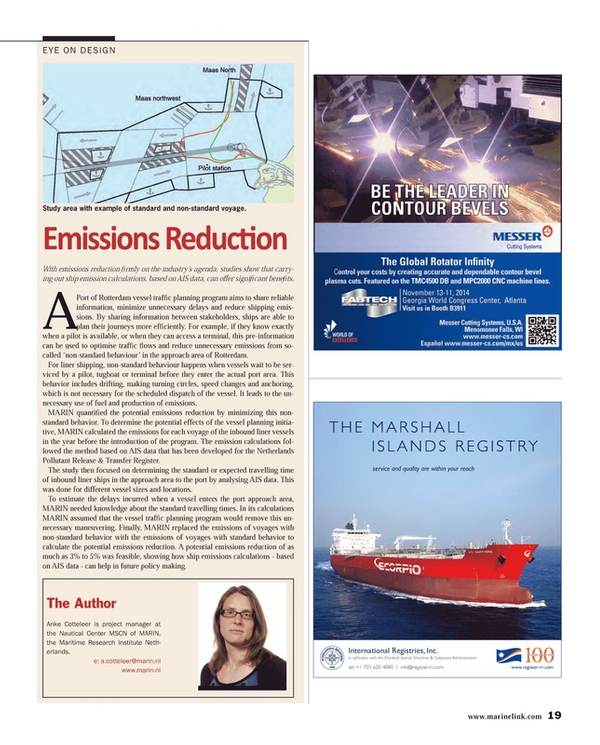
AIS Data for Emissions Reduction
With emissions reduction firmly on the industry’s agenda, studies show that carrying out ship emission calculations, based on AIS data, can offer significant benefits.
A Port of Rotterdam vessel traffic planning program aims to share reliable information, minimize unnecessary delays and reduce shipping emissions. By sharing information between stakeholders, ships are able to plan their journeys more efficiently. For example, if they know exactly when a pilot is available, or when they can access a terminal, this pre-information can be used to optimise traffic flows and reduce unnecessary emissions from so-called ‘non-standard behaviour’ in the approach area of Rotterdam.
For liner shipping, non-standard behaviour happens when vessels wait to be serviced by a pilot, tugboat or terminal before they enter the actual port area. This behavior includes drifting, making turning circles, speed changes and anchoring, which is not necessary for the scheduled dispatch of the vessel. It leads to the unnecessary use of fuel and production of emissions.
MARIN quantified the potential emissions reduction by minimizing this non-standard behavior. To determine the potential effects of the vessel planning initiative, MARIN calculated the emissions for each voyage of the inbound liner vessels in the year before the introduction of the program. The emission calculations followed the method based on AIS data that has been developed for the Netherlands Pollutant Release & Transfer Register.
The study then focused on determining the standard or expected travelling time of inbound liner ships in the approach area to the port by analysing AIS data. This was done for different vessel sizes and locations.
To estimate the delays incurred when a vessel enters the port approach area, MARIN needed knowledge about the standard travelling times. In its calculations MARIN assumed that the vessel traffic planning program would remove this unnecessary maneuvering. Finally, MARIN replaced the emissions of voyages with non-standard behavior with the emissions of voyages with standard behavior to calculate the potential emissions reduction. A potential emissions reduction of as much as 3% to 5% was feasible, showing how ship emissions calculations - based on AIS data - can help in future policy making.
The Author
Anke Cotteleer is project manager at the Nautical Center MSCN of MARIN, the Maritime Research Institute Netherlands.
e: [email protected]
www.marin.nl
(As published in the July 2014 edition of Maritime Reporter & Engineering News - http://magazines.marinelink.com/Magazines/MaritimeReporter)
Read AIS Data for Emissions Reduction in Pdf, Flash or Html5 edition of July 2014 Maritime Reporter
Other stories from July 2014 issue
Content
- Editorial: Gas ... It's Both the Question & the Answer page: 6
- FORAN Users Meeting (FORUM 2014) page: 11
- Harnessing the Wind for Auxiliary Propulsion page: 12
- OSRO: The Child of Necessity page: 14
- Electronic Navigation & Dispute Resolution: Coming of Age page: 16
- The Cause behind the Clause Piers & Docks Insurance page: 18
- AIS Data for Emissions Reduction page: 19
- Turbocharger Modification page: 20
- Interview: Roberto Cazzulo Talks Class Trends page: 22
- Desulfurization of Exhaust Gases in Shipping page: 26
- FLNG Prelude: A New Dawn in the Age of Maritime & Energy page: 30
- Prelude By the Numbers page: 36
- Floating Production: $1.2b Speculative FLNG Ordered page: 38
- Private Equity Drives New Ship Buys page: 40
- Business is Brisk at Posidonia in Athens page: 44
- American P&I Club Rings in Posidonia page: 47
- Unified Emissions Monitoring: Turbulo Bluemon page: 50
- TOTE Ship Receives Powerplant page: 50
- Thrustmaster, DOEN Ink Deal page: 50
- gplink: Remote Monitoring from Finning page: 51
- New Emergency Genset from Cummins page: 51
- Repowered Tug Tows Nonstop page: 51
- FPP Design from Wärtsilä page: 51
- Dynaligner Aims to Eliminate Shaft Misalignment page: 52
- Metal Thickness Gauge Launched page: 52
- New A/C Chiller for Medium to Large Yachts page: 52
- Bernard Offers MIG Gun Customization page: 52
- MEGAFIL Welding Wires page: 53
- Air Hoists Offer Safe & Efficient Lifting page: 53
- CS Unitec Floor Planer Helps Prep for Recoating page: 54
- New Products for Engineroom Ventilation page: 54
- Aluminum MIG Push-Pull Welding Packages page: 54
- Aluminum Oxide Fiber Discs page: 54
- New Cleaning Water Jet Nozzle page: 54
- Dr. Shrink's Extra-Wide Shrink Wrap page: 54
- ABS CErtifies SCIGRIP Adhesives page: 54
- ENC Production Software Launched page: 55
- New Spoolmatic Pro from Miller page: 55
- Bernard’s ‘Best of the Best’ Platform page: 55
- Combat Cold Corrossion via Condition Monitoring page: 56
- Mississippi Hosts Fourth Annual National SeaPerch Challenge page: 57


